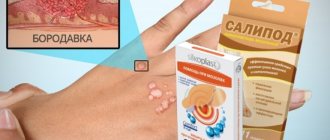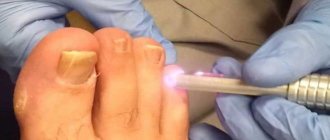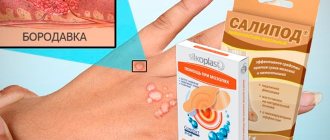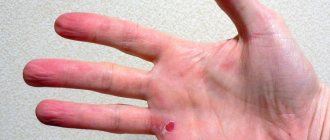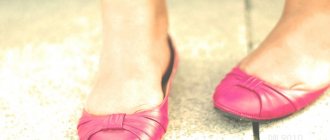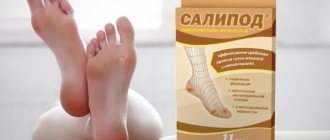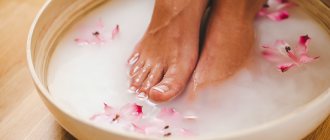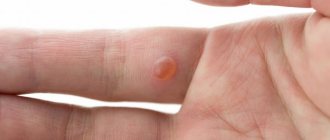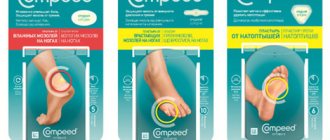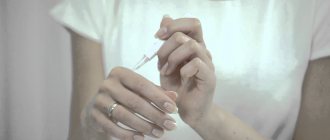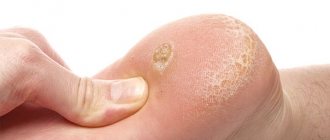Almost every person, after buying new shoes, first experiences discomfort when wearing them. Shoes can press on, compress the foot, but most often rub. Those who spend most of their time on the move know firsthand what calluses are. All people have at least once experienced this discomfort associated with rubbing their feet. When this problem arises, everyone asks the question: how and how to effectively combat calluses on the feet and what can help minimize the discomfort from uncomfortable shoes?
Classification of calluses
A dry callus is a limited area of yellowish, keratinized, thickened, dense skin.
Painful when located at the base of the fingers on the plantar or palmar surface.
Calluses on the heels lead to the formation of cracks, which can become painful and become infected.
Causes of dry calluses:
- work in a standing position
- long walk
- tight and narrow shoes
- working with tools (construction, musical, sports, power tools)
- dry skin where calluses form
- thinning of subcutaneous fat in areas where calluses form
A soft callus—otherwise known as a wet callus—is saturated with moisture and softens, forming blisters.
Microtraumas cause inflammation with damage to the deep layers of the skin.
Under the pressure of the released interstitial fluid, the surface epidermis rises.
Moisture sweats inside and bubbles form.
A typical place for the formation of such calluses is the interdigital folds.
Such calluses cause extreme pain and are dangerous when the bladder is opened due to the risk of infection.
Causes of soft calluses:
- microtraumas and cracks
- wet skin where calluses form
- thinning of the skin and subcutaneous fat
- tight shoes or tight wet gloves
- wet socks or stockings
- increased sweating of the feet
- thinning of the skin and infection
A core (or “ingrown”) callus is a dense, round area of hyperkeratosis.
With clear boundaries and a hard transparent whitish rod in the center, when viewed it resembles a lid.
They are formed in response to injury by a foreign body (stone, splinter) in places where bone bases press on soft tissue.
The rod consists of a stratum corneum, as hard as a nail plate.
Therefore, when vertical pressure is applied to the callus, severe pain is felt due to compression of the dermal nerves.
Callus must be distinguished from plantar warts, since the treatment indicated is different.
A plantar wart is similar in appearance to a callus, but its surface looks loose, with brown dots.
And pain appears with any pressure, including from the sides.
There is usually only one core callus, and small, daughter similar formations form next to the large wart.
Causes of callus formation:
- high heels shoes
- work in a standing position
- untreated soft callus
- viral and fungal infections
- microtrauma of the skin
- constant pressure or rubbing of a specific area of skin
- diabetes
- flat feet
Subungual keratosis, in which the nail folds appear as thickenings on the side of the nail plate in the form of a dense yellow-gray mass.
The nail becomes dense, dull, deformed, and partially destroyed on both sides.
Such formation may indicate a fungal infection of the nail.
Therefore, you should see a mycologist, as well as the development of panaritium or an ingrown nail.
Reasons for the formation of subungual keratosis:
- failure to comply with hygiene rules
- diabetes mellitus (diabetic foot)
- violation of the trophism of the skin of the feet
- nail phalanx injuries
Corns are areas of hardened skin on the plantar surface of the foot.
Causes of corns formation:
- tight shoes with insufficiently rigid and thin soles (calluses in the heel area)
- high heels (corns in the big toe area)
- displacement of the center of gravity with valgus or varus position of the feet (corns on the lateral surface of the foot)
- Reduced spring function of the foot due to flat feet (calluses all over the sole)
Children more often develop soft (“wet”, “weeping”) calluses that look like a bubble with liquid.
Reasons for the formation of a soft callus with a blister in children:
- Tight shoes
- Shoes with rough seams, made of leatherette
- Shoes that are too big (not the right size)
- Large socks or tights that bunch up when wearing shoes
In women, soft (“wet”) calluses are more common on the upper extremities when working in their summer cottage or in places where they are compressed by tight shoes.
Often, core and dry types of calluses appear as a result of constant pressure or friction.
For example, when working with sports (stick, dumbbells, barbells, clubs) or athletic (mechanical and electrical simulators) equipment.
Or when constantly carrying heavy loads.
Dry calluses are common among musicians, in particular on the fingers of a guitarist or calluses on the fingers and chin of a violinist.
Older people can develop all types of calluses.
Age-related dry skin stimulates the formation of dry calluses and corns.
Thinning of the skin leads to cracks and the formation of wet calluses; ingrown toenails are formed due to poor foot hygiene against the background of subungual keratosis.
Painful sensations and impaired sensitivity of the feet lead to the risk of falls in an elderly person, or even refusal to walk.
With a long course of the disease, bedsores may appear on the feet.
Types of skin defects
Calluses are small areas of dead and rough skin. They appear on the body in places where the skin is subject to strong friction, most often the feet or hands. There are four types of callus:
- rod;
- dry;
- water;
- corns
The core is most often located in the area of the little finger or big toe. It is also often found on the heels. This skin defect is characterized by a rigid rod that grows deep into the body. It is difficult to remove, but if this is not done, it will be impossible to walk due to severe pain.
A dry callus rises somewhat above healthy skin. This is an area of keratinized skin that may have a yellowish or grayish tint. Such a formation practically does not cause discomfort, but in an advanced stage it can form cracks, which will cause pain.
Water looks like a bubble with a thin transparent shell. The liquid in the bubble is also transparent, sometimes yellowish and cloudy. In the case where the capillary has been damaged, there may be an admixture of blood. These blisters are usually painful and make walking difficult. If not properly cared for, they can become infected or transform into a solid form.
A corn is a keratinized area of skin that does not have clear boundaries. Most often observed on the feet, and can also form on the hands.
Reasons for the formation of growths
Corns and chafing appear as a result of constant squeezing and rubbing of a certain area of the skin. Its cells die, do not have time to exfoliate and accumulate. A rough surface is formed.
On the feet, the formation of growths leads to:
incorrect gait;
- intense sports (running, skiing);
- shoes with rough internal seams;
- shoes with too thin soles;
- foot diseases (bursitis, flat feet, osteoarthritis);
- high-heeled shoes;
- shoes that are too narrow;
- not using socks.
Despite the fact that these roughness do not pose a threat to health, they can complicate life. Therefore, it is necessary to try to prevent their formation. This is not difficult to do. There are some rules to follow:
wear only comfortable shoes. It should fit in size, not dangle on the leg and not compress it;
- use socks only made from natural fabrics, such as cotton or wool;
- control weight;
- Every day after a shower, inspect your feet and lubricate the skin with nourishing foot cream;
- do not wear high-heeled shoes every day;
- When going camping or fishing, always take a callus bandage with you.
Remedies
Corns and other skin blemishes caused by friction do not require special treatment unless they cause pain. To eliminate them, a foot bath, pumice stone and nourishing cream will be enough. In more advanced cases, a professional pedicure in a salon will be required.
Difficulties are usually caused by formations on the skin with a rod. They must be removed. This can be done at home using traditional medicine or anti-callus patch . A doctor can also help by prescribing any of the methods for getting rid of calluses:
- Drilling. It is considered the most effective way. Using a special apparatus, a hole is drilled in the skin into which medications are placed to dissolve the rod.
- Laser therapy. The rod is cauterized with a laser.
- Cryotherapy. Liquid nitrogen is used for cauterization.
All these methods allow you to safely and quickly eliminate the defect. The skin will quickly recover, and the specialist will ensure that the rod is destroyed to the very base.
How to treat calluses at home
The best way to treat calluses at home, without involving a doctor, is to use special patches.
Pharmacies often offer a variety of products targeting different types of calluses.
Each patch has instructions included in the packaging or printed directly on it.
Mode of application:
- The limb should be lightly steamed and blotted dry.
- Lubricate the healthy part of the skin around the callus with baby cream or Vaseline.
- Remove the protection, place the membrane impregnated with the medicinal composition strictly on the skin defect
- Fix the patch and wear for 1-2 days
Patches for dry calluses
Patches often used for dry calluses should contain emollients and moisturizers and substances: urea or salicylic acid.
A patch with salicylic acid eliminates the stratum corneum, relieves local inflammation, and prevents the development of cracks.
The use of the patch in patients with allergic reactions is possible only after consulting an allergist.
The Leiko dry calluses patch is a fabric strip with a membrane impregnated with salicylic acid.
The application time for one patch is 2 days.
The Urgo salicylic patch features a foam pad that protects healthy skin from the effects of salicylic acid.
Perforation ensures the prevention of the “greenhouse effect”, preventing macerations.
Time to use the patch is 24-48 hours.
A clear disadvantage of the product is the risk of allergic reactions.
Hands remain a little sticky after use due to the adhesive base of the patch.
Salicylic acid is found in Chinese Jiyantie and Shulyangsuan patches along with phenol.
Has an antiseptic, softening, analgesic effect.
The use of patches in patients with diabetes and children is excluded due to high concentrations of active substances.
Plasters for dry calluses and corns are manufactured by the following companies:
- Dr. House
- Johnson & Johnson (Compeed dry callus patch)
- Hartmann (Cosmos patch for dry calluses)
Compeed and Cosmos foot callus patches have a translucent texture.
This allows them to be used on the hands, face, back of the foot, little finger).
In addition to softening, the patch provides an environment that stimulates active division and growth of new epidermal cells.
Luxplast spray patch is most often used for soft calluses.
But it is able to create a protective film that protects dry callus from further friction.
You can also use Foretal Plus cream, containing 25% urea in combination with phospholipids.
Instructions for use
Compeed patch for wet calluses reduces pain, prevents infection of the wound surface, and promotes rapid healing of calluses.
According to the instructions, the Compid patch for wet calluses should be glued to the damaged area. It is strictly forbidden to puncture a blister. The product is applied to previously cleansed skin. You can use wet wipes to remove dirt. Before gluing, the strip of adhesive plaster should be held in your hand so that it becomes pliable. Then you should carefully remove the protective one and stick the patch on the callus, while the edges of the adhesive patch should fit snugly to the surface of the skin.
The product remains on the skin for 24 hours. The first results are noticeable after a few minutes, when: pain and discomfort disappear.
To remove the adhesive plaster, gently pull the edges. You should not tear it off the surface of the wound with a sharp movement. If the surface of the wound has not completely healed, a new piece of plaster should be glued on.
Compeed dry callus patch is very easy to use. Before use, clean the surface of the skin from dirt. Do not use creams, oils or other cosmetics. The product should not be used if there are open wounds or ulcers on the skin area.
Before use, the patch should be warmed in your hands to body temperature. This will make it flexible and make gluing easier. After this, the protective film is peeled off and the product is placed on the corn so that the area with salicylic acid completely covers the growth. The time for using the patch is two days. Then the adhesive plaster is removed and a warm foot bath is given , which will help soften the rough skin.
Plasters for core calluses
For core calluses, the choice is usually the Salipod patch.
It contains salicylic acid, precipitated sulfur, lanolin and natural rubber.
A fragment is manually cut out of the patch, the shape and diameter corresponding to the callus core.
It is applied to it and secured on top with an adhesive plaster for 48 hours.
If there is no effect, Salipod is reused.
This patch is very effective, but has a number of contraindications.
These are pregnancy, early childhood, allergic reactions, open wounds and moles at the site of callus formation, elderly and senile age, diabetes mellitus.
Care must be taken not to allow the Salipod patch to attach to healthy skin: burns are possible.
Compeed and Cosmos patches are used for ingrown calluses.
They are made using hydrocolloid “second skin” technology, which prevents infection after removal of the rod.
The best anti-callus adhesive plasters
A few years ago, the range of anti-callus patches was small. Most often they were ordinary cotton strips on an adhesive fabric backing. They almost did not contribute to the restoration of the skin, but only protected it from friction and dirt. These Velcro strips came off quickly, especially if the skin sweated, and they also crumpled, slipped, and exposed damaged skin.
Now in pharmacies the selection of adhesive plasters is simply huge. These are ordinary fabric products, as well as silicone, gel, hydrocolloid and many others. They quickly and painlessly eliminate skin defects, prevent the development of infection, relieve inflammation and pain, and eliminate discomfort when walking.
You can get the expected result only if the remedy is chosen and used correctly. For a specific type of skin defect, certain adhesive plasters are produced. The packaging always contains instructions. It is recommended that you familiarize yourself with it and strictly follow it so as not to further damage the skin.
Most adhesive plasters have the same principle of action . They may differ in water resistance, exposure time, composition of active substances and shape. Before applying the patch to the affected area, you must do the following:
steam the affected area in a bath of hot water for 10-15 minutes;
- wash the skin with soap;
- dry the skin thoroughly;
- Use chlorhexidine to disinfect the damage and let it dry;
- remove the protective film from the prepared treatment sticker;
- Gently apply the healing part to the sore spot. Smooth the adhesive surface;
- stand for the time recommended by the manufacturer;
- If your skin is highly sensitive, it is better to avoid a steam bath.
Proven Salipod
Among domestic patches, the most popular is Salipod. It has earned the love of customers due to its effectiveness, ease of use and affordable price. This callus patch for dry calluses can be used on all areas of the foot. It includes:
=Sulphur. This is an excellent antiseptic for the deep layers of the skin;
- Salicylic acid. It dissolves dead cells, prevents the development of fungus and has an antimicrobial effect, and is also a conductor for sulfur;
- Lanolin. Perfectly softens the skin;
- Rosin. It has bactericidal properties.
It is recommended to stick Salipod on for 48 hours. Then it is removed, a steam bath is prepared and the skin is treated with pumice. If one procedure is not enough, it can be repeated every other day. These two-day compresses can be repeated no more than four times. During this time, Salipod is able to remove even very old formations.
The product is not recommended for use in the following cases:
children under 14 years of age;
- patients taking anticancer drugs;
- if the product cannot be applied without touching a birthmark, open wound or burn;
- patients with diabetes mellitus. After using Salipod, microdamage to the skin may appear. In diabetes mellitus, such damage heals quite difficultly and can cause infection;
- with renal failure;
- during pregnancy and lactation;
- if a zinc oxide product must be used on the damaged area.
Salipod rarely causes side effects. Sometimes, after repeated application, the following may be observed at the application site:
- redness;
- burning;
- itching;
- dermatitis.
Compeed by Johnson & Johnson
Without exaggeration, we can say that Compeed patches were created for all occasions. Compeed can be applied between and on the toes, heels and instep. This product can successfully combat all types of chafing and also prevents their occurrence.
Compeed uses hydrocolloid technology to produce it. Thanks to this, Velcro acts as a second skin. Externally it looks like silicone. Its safe adhesive substance can isolate nerve endings, reducing the intensity of pain. The breathable top layer is able to repel water and protect against friction, bacteria and pressure.
Compeed has the following advantages:
- prevents crust formation;
- waterproof;
- holds even in hard-to-reach places;
- almost invisible on the skin;
- located in a convenient plastic container;
- pleasant to the touch;
- allows the skin to breathe;
- isolates nerve endings;
- protects against moisture and infection.
The manufacturer also produces a gel-like anti-callus pencil. It is applied to damaged skin until it blisters or becomes rough. The product is colorless, making it completely invisible on the skin. Suitable for use by children.
It contains astringent and antiseptic components. The gel stick works as a natural lubricant, instantly reducing friction. In nine out of ten cases, it prevents the formation of blisters.
Dr. House
The pharmaceutical company Wellness Medical produces a whole line of adhesive plasters called Doctor House for the removal of calluses and corns. These anti-callus stickers are based on a hydrocolloid pad. It speeds up the resorption time of the blister and relieves pain.
For dry growths, the patch is additionally impregnated with salicylic acid. No more than two stickers will be needed to treat blisters. To deal with old chafing, you will need to use three to five adhesive bandages.
Urgo patch
Urgo stickers from a French manufacturer allow you to get rid of corns, warts and old dry calluses. They differ from competitors with foam padding. It helps protect healthy tissue from the effects of salicylic acid.
The sticker includes:
- 32 grams of salicylic acid;
- beeswax;
- silica;
- copper.
Salicylic acid in the composition allows you to dissolve the stratum corneum of the skin, which is located in the callus area. The patch must be changed daily after the bath. The number of applications is not limited. Stop using the product until the defect is eliminated only if itching or an allergic reaction occurs. Urgo should not be used on infected calluses.
Cosmos for all occasions
Cosmos hydrocolloid stickers are designed to treat both wet and dry calluses. The sticker applied to the blister transforms into a gel. It absorbs secreted fluid, reduces pressure and pain, and protects against infection. Applied to dry calluses, the hydrocolloid composition intensively moisturizes and softens it. This creates a favorable environment for the restoration of skin cells.
Cosmos is made of translucent material. This makes it great for open-toe shoes. The adhesive plaster does not peel off or roll off and holds well even during intense running.
Cosmos adhesive plasters have the following advantages:
- the material from which the sticker is made does not tighten the skin;
- the hypoallergenic glue that the manufacturer uses does not cause an allergic reaction even in sensitive people;
- has high dirt-repellent properties;
- allows short contact with water;
- pain goes away after the first use of the drug;
- economical, one sticker can be used for two days;
- transparent and thin base that does not catch the eye;
- allows water vapor and air to pass through;
- affordable price. The average cost of an adhesive plaster is 100 rubles. For such an economical and effective product, the price is really low.
The best cure for calluses is prevention. Comfortable shoes, nutrition and hydration of the skin of the feet prevent the development of corns. If it was not possible to avoid trouble, an anti-callus adhesive plaster will help get rid of the blister or stick.
A large selection allows you to quickly and painlessly get rid of skin defects. The main thing is to choose the right product and use it according to the instructions.
Patches for soft (wet) calluses
The patch is aimed at preventing wound infection, protecting damaged skin, resolving blisters and relieving pain.
Such patches are made from hydrocolloid materials that act like a “second skin.”
It is strictly contraindicated to open the blisters on your own.
This leads to infection and, upon healing, to disfigurement of the skin area.
If the bubble has opened, the skin around the wound is treated with hydrogen peroxide or furatsilin solution.
A medical plaster or self-adhesive bandage with a bactericidal effect is applied to the wound.
Compeed (manufactured by Johnson & Johnson) and Cosmos (manufactured by Hartmann) patches are made from colloidal substances that promote healing.
Plaster Dr. House has a hydrocolloid pad.
The application time for one patch is 24 hours.
Luxplast spray patch for wet calluses creates a hydrocolloidal waterproof protective film by spraying, drying within 30 seconds.
Apply once a day until the wound is completely healed.
Used in the treatment of wet calluses in children.
Liquid patches Emplasto, Gehwol (gel patch - callus pencil) are applied to the skin, forming a protective film.
The liquid patch contains mild astringents and antiseptics; it can be applied even to a child.
Efficiency and in what cases it helps
The result of applying the Compeed patch is felt instantly. The pain goes away in the first seconds, the healing process is comfortable and painless. The effectiveness of this product is high. It prevents infection from penetrating into the wound, quickly restores, and does not allow calluses to grow to great depths, causing active regeneration in the tissues.
Depending on the problem, the manufacturer has developed several forms of patches:
- Pencil to prevent wet blisters at the first sign of chafing. Forms a transparent but durable film on the surface, instantly eliminating pain, eliminating dryness, and softening friction. Advantages: convenient method of application, does not peel off, does not leave stains, is not visible, suitable for wearing with open shoes.
- For ingrown calluses. Provides reliable protection from mechanical stress, prevents ingrowth to great depths, softens, moisturizes, helps normal oxygen exchange, and prevents infection.
- For wet calluses. This is an ambulance to relieve pain from already formed calluses. Protects against bacteria and moisture. A thin layer of coating allows the skin to breathe and remove excess moisture. For growths, a small size of adhesive plaster is provided, for blisters - a medium size.
- From injuries between the fingers. A convenient shape that allows you to protect your finger from the formation of deep bleeding wounds. Securely attaches to the skin, lasts for a long time, heals, protects from friction and pressure.
- For corns on the soles. The heel and sole of the foot are subject to pressure. It is difficult to cure tumors in these places. The Compid patch, resistant to water and mechanical stress, accelerates tissue regeneration and eliminates rough calluses.
The range of products is wide, which makes its use always effective and convenient.
Protective plasters
To prevent the formation of calluses, protective patches are used.
The callus patch, like the protective patch, can be applied to any area of the skin.
On the little toes, between the toes, on the ball of the foot, on the heels, on the palms.
Silicone patches (Compeed patch), liquid patches and spray patches are considered the best.
The main disadvantage of silicone callus plaster is its high price.
Which plaster for calluses is better?
- the one that is applied to the callus in a timely manner
- corresponds to the type of callus
- Fits tightly and is easy to remove
- does not cause allergic reactions
If the patch for calluses does not provide the required effect, you should contact a podologist or podiatrist, a specialist in therapeutic (medical) pedicure.
A cosmetologist or cosmetology nurse will also help get rid of defects.
In more serious cases, it is necessary to visit a dermatologist, mycologist or simply a surgeon
Preventing the formation of calluses
- hygiene of the skin of the feet and hands, timely pedicure
- maintaining sufficient skin hydration
- avoid wet hands and feet (socks, gloves, prolonged exposure of hands and feet to water)
- comfortable shoes that fit well, with a wide toe and a hard heel
- shoes with dense soles with some elevation in the heel area, well-finished edges, smooth insoles
- changing shoes several times during the season
- massage of hands and feet, therapeutic exercises
- thorough treatment of soft and dry calluses, avoiding complications
- avoid microtraumas, including permanent traumatization by a foreign body
- don't cut calluses
- use protective plasters if there is a risk of callus formation
If calluses appear, contact the author of this article, a dermatologist in Moscow with many years of experience.
